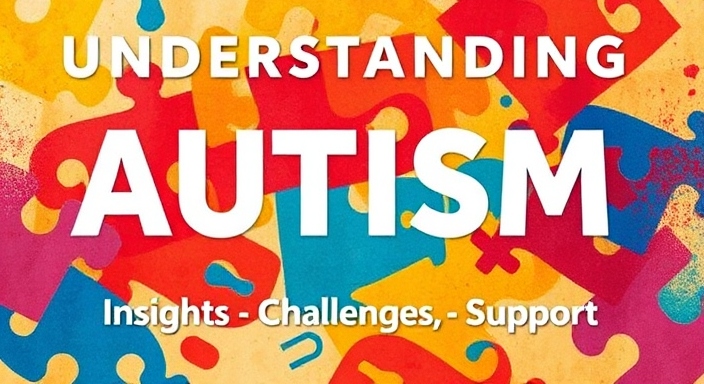Autism Spectrum Disorder (ASD) is a complex and multifaceted neurodevelopmental condition that,affects how individuals perceive and interact with the world around them. It encompasses a wide range of symptoms and behaviors, which is why it is referred to as a “spectrum.” Understanding autism is essential for fostering awareness, acceptance, and support for those affected by it. In this blog, we will explore what autism is, its symptoms, potential causes, and effective ways to support individuals on the spectrum.

What is Autism?
ASD is characterized by challenges in social communication. It also includes restricted interests and repetitive behaviors. The symptoms can vary significantly in severity. Some individuals may require substantial support. Others may need minimal assistance.. Autism can be diagnosed at an early age. Many signs become noticeable during the first few years of life. Although there is no cure for autism, early intervention is crucial. Tailored support can lead to improved outcomes. It can also enhance the quality of life for those affected.
Common Symptoms of Autism
Symptoms of autism can be categorized into two main areas: social communication challenges and restricted or repetitive behaviors.
Social Communication Challenges:
–Difficulty with Social Interactions: Individuals with autism often face challenges in social interactions, including difficulties understanding social cues, maintaining conversations, and interpreting nonverbal communication, impacting their ability to form and navigate relationships effectively.
-Communication Delays:Individuals with autism often experience difficulties with social interactions. These challenges can stem from issues in understanding nonverbal cues, maintaining conversations, and recognizing social norms. As a result, they may find it hard to connect with peers and navigate social situations effectively. These hurdles can lead to feelings of isolation and frustration. Supportive environments that promote understanding and communication skills are essential for helping individuals navigate social situations more effectively.
Difficulty With Empathy: Individuals with autism may have trouble interpreting or expressing emotions, making it hard for them to recognize how others feel.
2. Restricted and Repetitive Behaviors
–Repetitive Movements: This can include hand-flapping, rocking, spinning, or repeating phrases. These behaviors can provide sensory stimulation or help with self-regulation.
-Intense Focus on Specific Interests: Many individuals develop deep and passionate interests in specific topics, often to the exclusion of more diverse activities.
–Resistance to Change: People with autism may find changes in routine distressing and may prefer predictability in their daily lives.
Potential Causes of Autism
The exact causes remain largely unknown, but research suggests that both genetic and environmental factors contribute to the development of the disorder. Some potential contributors include:
Genetics: Studies show that autism tends to run in families, indicating a genetic component. Certain genetic mutations have been associated with the disorder.
Environmental Factors: Prenatal exposure to certain medications, particularly anticonvulsants, has been associated with an increased risk of developing autism spectrum disorder (ASD). Additionally, infections during pregnancy—such as maternal rubella or other viral illnesses—can also contribute to the likelihood of autism. Furthermore, complications during birth, including low birth weight or oxygen deprivation, may further elevate this risk. Understanding these potential factors can help in assessing and managing risks associated with autism. Understanding these factors is crucial for guiding early intervention strategies and providing targeted support.
Neurological Differences: Neurological differences in individuals spectrum disorder (ASD) often result in variations in brain structure and function. These differences can influence behavior and cognitive processing. Research indicates abnormalities in brain size and connectivity. Specific brain regions, such as the prefrontal cortex and amygdala, often show atypicalities . These variations can impact social cognition and sensory processing. They also affect executive function. Individuals with ASD may struggle to understand social cues. They often have unique responses to sensory input. These differences highlight the diverse neurodevelopmental profiles within the autism spectrum. Understanding these neurological variations is essential. It helps develop effective interventions and supports tailored to individual needs.
Early Intervention and Support
Early diagnosis and intervention are critical for helping individuals with autism reach their full potential. Some effective strategies include:
- Therapies
Applied Behavior Analysis (ABA): A widely recognized therapy that uses reinforcement techniques to encourage desired behaviors and decrease challenging ones.
Speech Therapy: Speech therapy is a vital intervention for individuals Spectrum Disorder (ASD), as it focuses on improving their communication skills, which can significantly enhance social interactions and overall quality of life. Tailored to each person’s unique needs, speech therapy may include techniques to develop verbal communication, promote effective non-verbal communication, and improve understanding of language in context.

Occupational Therapy: Occupational therapy (OT) plays a crucial role in supporting individuals by enhancing their ability to engage in daily activities and improve their overall quality of life. OT focuses on developing essential skills such as self-care, social interaction, and sensory processing, which can be challenging for many on the autism spectrum.
2 . Educational Support
Educational support for individuals is essential for fostering their learning and development in a structured environment. Tailored interventions such as Individualized Education Programs (IEPs) offer customized learning strategies that accommodate the unique needs and strengths of each student . These programs often include specialized teaching methods, social skills training, and support from speech or occupational therapists, ensuring that students can navigate academic challenges effectively.
3. Social Skills Training
Social Skills Training (SST) for individuals with autism is a structured approach designed to enhance their ability to interact and communicate effectively with others. This training focuses on teaching essential social nuances, such as initiating conversations, understanding non-verbal cues, and developing empathy.

4. Family Support and Resources
Families of individuals with autism can benefit from support groups, educational resources, and counseling. These resources can help families understand the challenges associated with autism and guide them in advocating for their loved ones.
Fostering Awareness and Acceptance:
By increasing awareness and understanding of autism, society can create a more inclusive environment. Here are some ways to promote acceptance:
Education: Share information about autism in schools, workplaces, and community settings. Understanding can reduce stigma and foster empathy.
Advocacy: Support policies and initiatives that promote the rights and needs of individuals with autism, including access to education and healthcare services.
Celebrate Neurodiversity: Recognize the unique strengths and abilities of individuals with autism. Emphasize that diversity in cognitive processing and perspectives enhances society as a whole.
Conclusion
Autism is a complex condition that varies significantly from person to person. Supporting individuals with autism requires understanding, patience, and a commitment to fostering inclusion. By promoting awareness and acceptance, we can work together to create a world where individuals on the autism spectrum are celebrated for their unique contributions and can thrive in their communities.
If you or someone you know is navigating the challenges of autism, remember that you are not alone. Numerous resources and communities are available to provide support and guidance. Together, let’s continue to learn about and champion the rights and experiences of those with autism.
Thank you for visiting. Please leave a comment about the article.
Discover more from fuel for life
Subscribe to get the latest posts sent to your email.
